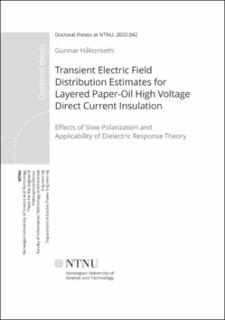| dc.description.abstract | The aim of this work is to contribute to an increased capacity of mass-impregnated, high voltage direct current (HVDC) cables. This has been done by providing a better understanding of the transient electric field distribution between impregnated paper and oil-filled butt gaps. The focus is in particular how this field distribution is affected by the dielectric response functions of oil and impregnated paper.
In this work, mass-impregnated HVDC insulation was modeled mathematically as a series connection of two materials, namely oil and impregnated paper. The model was based on linear dielectric response theory. A system of differential equations for estimating the time-dependent electric field distribution and the current density was established as part of the model. The input parameters to the model were thickness, high-frequency permittivity, steady-state conductivity, and dielectric response function for each material separately, as well as the applied voltage across the whole series connection. The dielectric response functions were here used to represent any polarization and conduction processes that were not represented by the high-frequency permittivities or steady-state conductivities. The model was used to estimate electric field distributions in plane-parallel, mass-impregnated insulation with and without dielectric response functions considered.
An air-tight, temperature-controlled container was equipped with necessary piping, bushing, and electrodes for vacuum drying, impregnating, and electrical testing of plane-parallel test objects. The test objects were made of paper and oil of qualities typically used for mass-impregnated cables. Some of the test objects contained impregnated paper, some contained only oil, and some contained an oil gap between stacks of paper. A test circuit for applying step voltages and measuring the resulting polarization and depolarization currents was built and connected to the electrodes via the bushing. Dielectric response functions and steady-state conductivities were determined from the polarization and depolarization currents for oil and impregnated paper separately. This was done at 50 °C with electric field strengths ranging from 0.3 to 7 kV/mm for oil and from 0.2 to 40 kV/mm for impregnated paper. The permittivity for each material was determined from measurements at 1 kHz and 0.7 Vrms. The measured electrical properties were used as input to the above mentioned model. Furthermore, polarization and depolarization currents were measured in a 2.5 mm thick plane-parallel series connection, i.e. an oil gap between stacks of paper, at 30.6 kV. The measured currents in the series connection were compared with currents estimated by the model. To ensure that the comparison was relevant, the currents in the series connection and the electrical properties used as input to the model were measured under as similar conditions as possible. Paper without impregnation was studied with scanning electron microscopy to assess its internal, porous structure.
The agreement observed between measured and estimated currents indicates that linear dielectric response theory is adequate for estimating the transient electric field distribution between layers of oil gaps and impregnated paper. Further, it was found that the dielectric response functions strongly affect how fast steady state is approached. For example, in a particular piece of insulation at 50 °C, the estimated time needed for ninety percent of the change from initial to steady-state electric field distribution to take place was at least twice as long when dielectric response functions were taken into account than when they were neglected. Further, it was observed a trend that the time needed for this change to take place decreases and becomes less affected by the dielectric response functions as the ratio of total paper thickness to total oil gap thickness in the insulation is increased. The scanning electron microscopy showed that typical thicknesses of interstices between paper fibers were less than 15 % of the paper sheet thicknesses. This confirmed that oil gaps in such interstices are much smaller than butt gaps and thus can be modeled as part of the impregnated paper. | en_US |
